CONVERSATION 2012
Omni Hilton Head Resort
Hilton Head, South Carolina
March 28 - 31, 2012
From the fabric of our three earlier discussions, we asked where Conversation 2012 should go if we were to continue to add value. We concluded that we are now more poised to emerge from the mandorla of 2011 and seek to embrace the discipline of scenario thinking to help us imagine distinct images of possibility and further valuable perspective on the work of social change and philanthropy. That is the framework of this year's gathering.
Summary Highlights
Sixteen social sector and philanthropy leaders from the U.S. and Canada gathered in late March on Hilton Head Island for four days of scenario thinking about the sector and philanthropy in the year 2030. Our main focus question was: "What will the social sector ecology in North America be like in 2030 and will philanthropy be innovative and sufficiently responsive to propel real and lasting change for all?"
Well in advance, the group had identified the two forces deemed most import and most uncertain. These became our driving forces for scenario thinking. They were:
Driver 1: Approaches to pressing public social issues, mandates (education, health, retirement, employment, immigration, hunger, borders, justice)
Driver 2: Society's orientation to philanthropy (institutions or informal networks and incentives or tight limits)
The intersection of those drivers created four possible scenarios, which framed our thinking about the emerging story of each scenario.
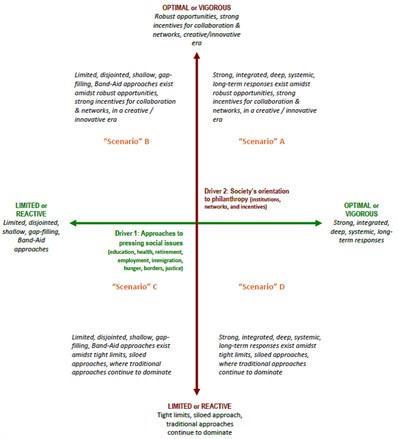
Scenario A: ELEVATED INTENTION
In this scenario, we envision a strong, robust future with deep, systemic, long-term responses to pressing social issues. Expansive opportunities for innovative philanthropy leverage strong incentives for networking and collaboration.
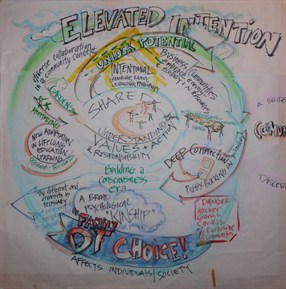
Near universal access to technology enhances awareness, promulgates engagement, and "levels the playing field." What's been kept out of sight no longer remains invisible. More people have access to more knowledge; consequently, change occurs more quickly. A widely-enhanced consciousness and broad psychological kinship act as catalysts for change. Levels of institutional trust are high. Government is an equal partner with the public and private sectors, resulting in significant and lasting responses to a wide range of social issues. Boomers pass the torch to millennials, who have been groomed for leadership. Family continues to be redefined, reflected in extended "families of choice." At a macro level, great emerging promise creates a groundswell of hope. Growing numbers of stakeholders are at the table and engaged in collective problem solving around social issues; collective impact is widely embraced.
Philanthropy is alive and well-though not in the traditional form of the rich giving to the poor. Shared accountability is increasingly the norm. People offer and are valued for contributing what they can, where they can, and how they can in the form of time, money, expertise, etc. Money is less concentrated, and "currency" takes different forms (with bartering an increasingly common medium of exchange). A shift in power relationships results in more true and equal partnerships-which yield far more effective and lasting results. Band-Aid solutions and responses, though still applied, are a far less common expression of philanthropic spirit.
Some danger signs remain. Disaffected groups include hackers, gangs, cartels, and other exclusive communities. Those who are deeply resistant to change and/or who are the most disenfranchised reap fewer benefits from the collective advances.
Scenario B: LIGHTS AND SHADOWS
This scenario is an environment of limited, disjointed, shallow, gap-filling, Band-Aid approaches to social issues amid expansive opportunities for innovative philanthropy with strong incentives for collaboration and networks.
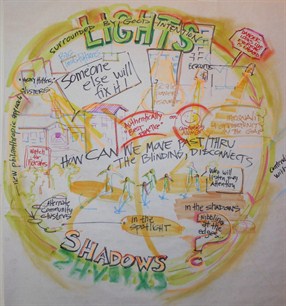
The landscape features a largely unperceived and widely undesired distancing between the "beacons" (organizations and individuals that attract the philanthropic spotlight) and the rest-resembling North America of today. Most in the spotlight believe that someone will "figure it out"-and consequently continue to reinforce the view that they (the "spotlights") will lead everyone else out of the wilderness.
One signal of the underlying problem is right-sounding messages and seemingly inclusive action by the spotlights-including convened gatherings of grassroots people and organizations that appear to bridge divides. The minority see the unequal yoking-leading to tension between real and perceived partnerships. Well-intentioned words and actions ultimately encourage a hidden but growing dependency across many sectors and geographies.
Due in large part to the increasing social service needs of aging boom generation, economic malaise persists until 2017. It is followed by an overall rebound-but a shrinking of the middle class. People band together to create their own economies as bartering becomes increasingly prevalent among the new middle class. Those in the spotlight are challenged to focus energy and resources in more obvious places as increasing numbers of the economically disadvantaged demand a response. Hard choices of where to focus resources result in heavily-supported, compliant populations and communities with completely neglected sectors and geographies (those that are often the most difficult to reach and work with). Changes in tax provisions for charitable contributions compound the problem-sometimes pitting government against charitable organizations in competition over who has greater impact for the dollar.
As in all the scenarios, technology plays a huge role. Here there is great appeal for every "bright, shiny object." The majority seeks to maintain the status quo and control outcomes. Some value the path of least resistance, seeking the paternal leader to make tough decisions. The allure of widely-adopted "best practices" continues (only deflecting real responsibility). The decades leading to 2030 cause many people to grow comfortably numb. Hence, they delude themselves into thinking they're doing the most relevant and important work because they're pursuing "best practices"-a view which is intrinsically past rather than future leaning.
Grassroots giving increases, fueled in part by accessible mobile technology and generational lifestyle choices. Peer-driven, largely unstructured impulses for targeted fundraising become common. Government support rewards the beacons at the expense of also-rans. "Spotlight" organizations continue to evoke constituent loyalty. Small donors and shadow organizations generate interest but little loyalty-embracing the attitude that, "It's the result that matters, not the entry point."
Scenario C: LONG SLOG
This scenario is characterized by limited, disjointed, shallow, gap-filling, Band-Aid approaches to social issues, while tight limits, siloed, and traditional approaches to philanthropy continue to dominate.
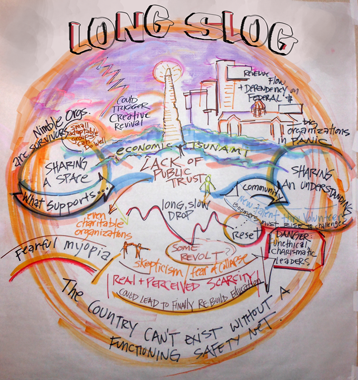
A singular economic tsunami or a series of smaller economic disturbances (war, Avian flu, Citizens United Pt. 2) keep the U.S. and much of North America in a weakened state until the mid-2020s. For many, a widely-shared malaise and anxiety (perhaps encompassing an entire generation born into an era of uncertainty and high anxiety) extends the need for human services to unprecedented levels. However, governments reduce funding for human services; organizations dependent on such funding become more fragile. Some previously high-profile and large social sector institutions fail to adapt and disappear. This is the long slog, with many hunkering down for survival and/or fearing total collapse. Rampant loss of trust and a short-term view foster a frightened myopia, resulting in an environment conducive to unethical but charismatic leaders and Tea Party-like movements.
The dominant value of competitive consumerism thrives at the expense of environmental protection. Despite pervasive promotion of all things green and environmentally friendly, the majority values the environment only to the extent that it poses no personal conflicts, thereby compounding increasingly problematic issues and challenges.
There is a continued acceleration and broad dispersion of communication technology at comparatively affordable prices. Ironically, however, value continues to be placed on personal, real-time connection with people. Personal privacy is significantly compromised, due to the fact that all our online data footprints are stored and potentially searchable by others. Higher education experiences major reinvention, with technology democratizing instruction at a time when economic compression calls for alternatives to traditional public and private colleges.
Mega-regions and larger cities grow. People with access to affordable health care live longer. Otherwise, many have shorter life expectancies. Boomers continue to play leadership roles, but in part-time, advisory, less authoritative ways. Gen Xers and millennials remain self-absorbed and me-focused, leaving elder boomers to face the reality that they must be self- and co-dependent.
In general, society drifts further from mainline churches and organized religion, yet individuals increasingly search for the spiritual dimension of life. A few radical religious groups increase the social threat. Public trust in mainstream media disappears, replaced by infinite "channels/outlets" that align with personal points of view. Civil discourse to solve problems is replaced by polarization and mean-spirited behavior. People are more willing to challenge organizations/institutions, adding to the pressure on individuals and organizations to be perpetually authentic.
Philanthropy largely reacts to economic limits and disturbance-forcing the collapse of each sector to "the few" most efficient organizations. The resulting clash reduces trust in charitable organizations. A tax revolt threatens and limits charitable tax-exempt status. Business decisions that result in the creation/combination of non-profit mega-organizations unintentionally erode the case for big organization philanthropy. While overall donation amounts remain stable, the local, personally known, smaller NGOs benefit from redistributed giving. Grass roots giving increases, largely responding to a pervasive sense of urgency and Band-Aid approaches. Individual fundraising professionals constantly battle donor fatigue.
Scenario D: TRIBES AND NETWORKS
In this scenario, we envision a strong, robust future with deep, systemic, long-term responses to pressing social issues-yet with tight limits, siloed, and traditional approaches to philanthropy continuing to dominate.
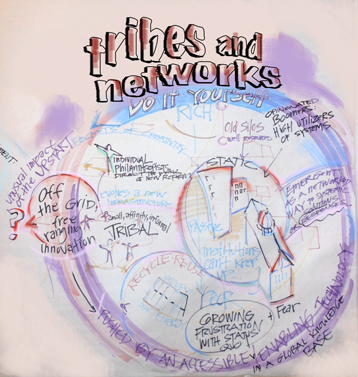
By 2030, a growing movement of non-traditional, individual, community-based efforts offers efficient and effective responses to challenges. The previous two decades have been turbulent. European debt and Asian markets and competition contribute to continued economic volatility. While major wars are averted, several natural catastrophes stunt economic growth. Emerging industrial countries resist environmental regulation, opting to improve quality of life at the expense of the environment. U.S. politics remain paralyzed by polarization, except in immigration and health care policy, where pragmatic approaches prevail (including mass amnesty for illegal aliens). Aging baby boomers have largely retired, driving increased demand for health care and other services. More women enter the workplace.
U.S. education reform is driven by local and state government, and aided by business (which depends upon an educated workforce). Education is increasingly segmented, with multiple alternatives to public education-including home schooling, on-line education, charter schools, and combinations thereof. Large corporations establish their own systems (beginning with preschool) to develop a more skilled workforce. Students who remain in public education systems face increasing challenges and have fewer resources-increasing the gap between haves and have-nots.
The response to turbulence is a new kind of local initiative-"tribalism" in the best sense-not narrow, self-interested defensiveness, but a positive mobilization of local talents informed by international sources of knowledge, with technology as the fulcrum. This tribalism becomes the source of the most creative, long-term solutions, a way to drive responses to social challenges. It is embodied by local, sustainable food economies; local policies and technologies reducing demand on nonrenewable energy sources; and multiple creative avenues for access to education, finance and best practices serving local needs.
Pressing social and economic needs are met by emerging local and personal strategies-which are advanced by technology and new models of social benefit organizations. Optimism and hope in philanthropy stem from an increasing number of very wealthy people signing onto Warren Buffett's pledge. Multi-billionaires are increasingly coming together to solve huge challenges using such informal, "off the grid" means as giving circles, personal (rather than institutional) philanthropy, and/or advised funds at community foundations and financial services companies. Individual philanthropists, not institutions, drive change. Nonprofit organizations are conduits, rather than knowledge sources and drivers of what to do and how.
Even people with modest resources feel empowered, because technology gives them access to networks of like-minded people who pool their resources to create impact. The millennial generation follows in the footsteps of baby boomers, embracing an approach to philanthropy marked by advocacy and activism. While some use traditional structures to advance personal philanthropic aims, there is a prevailing distrust of institutions, including government, corporations, and large nonprofits that remain siloed and slow to change.
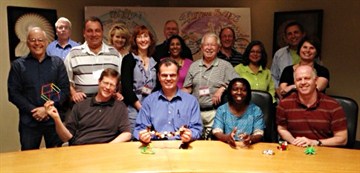
Joining Gary and Ken Hubbell for this year's Conversation are:
1. Jeff Anderson - Oregon Community Foundation (Portland, OR)
2. Marv Baldwin - Foods Resource Bank (Chicago, IL)
3. Jay Barber - M.J. Murdock Charitable Trust (Vancouver, WA)
4. Kay Edwards - Vesper Service Network (Milwaukee, WI)
5. Jim Hodge - Mayo Foundation (Rochester, MN)
6. Musimbi Kanyoro - Global Fund for Women (San Francisco, CA)
7. Elaine Martyn - Global Fund for Women (San Francisco, CA)
8. Patricia Modrzejewski - Providence Health & Service Foundation (Burbank, CA)
9. Shari Scales - Providence Cancer Center (Portland, OR)
10. Tom Soma - Ronald McDonald House Charities (Portland, OR)
11. Don Taylor - Chandler Group (Minneapolis, MN)
12. Pearl Veenema - Hamilton Health Sciences Foundation (Hamilton, ON)
13. Glenn Williams - Principia (St. Louis, MO)
14. Joseph Zanetta - Providence Little Company of Mary Foundation (Torrance, CA)
Conversation 2012 Publications
-
Conversation 2012 Distillation
-
Conversation 2012 Monograph
-
Scenario Stories Contributed by Conversation 2012 Participants: